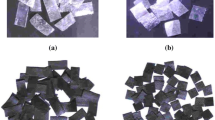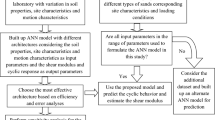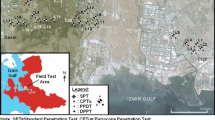Abstract
Tire waste additions to sand enhance the shear strength of sand for embankments. Granular and fiber shape tire wastes and their mixture with sand under drained and undrained conditions were tested in triaxial compression apparatus and modeled using neural networks (NN). In the experimental study, tire crumb and tire buffings inclusions were used at varying contents as soil reinforcement. Both quick tests and consolidated drained (CD) triaxial tests were performed to analyze the effects of tire content, tire shape, and tire aspect ratio on the shear strength of sand. Then, this extensive experimental database obtained in laboratory was used in training, testing, and prediction phases of three neural network-based soil models. The input variables in the developed NN models are tire wastes content, tire wastes type, test type, effective stress, and axial strain, and the output is the deviatoric stress. The accuracy of proposed models seems to be satisfactory. Furthermore, the proposed models are also presented as simple explicit mathematical functions for further use by researchers.

















Similar content being viewed by others
References
RMA (2006) Scrap tire markets in the United States, Rubber Manufacturers Association, November
Zornberg JG, Cabral AR, Viratjandr C (2004) Behaviour of tire shred-sand mixtures. Can Geotech J 41:227–241
Moo-Young H, Sellasie K, Zeroka D, Sabnis G (2003) Physical and chemical properties of recycled tire shreds for use in construction. J Geotech Geoenviron Eng, ASCE 129(10):921–929
Foose GJ, Benson CH, Bosscher PJ (1996) Sand reinforced with shredded waste tires. J Geotech Geoenviron Eng, ASCE 122(9):760–767
Hataf N, Rahimi MM (2005) Experimental investigation of bearing capacity of sand reinforced with randomly distributed tire shreds. Construct Build Mater 20:910–916
Attom MF (2005) The use of shredded waste tires to improve the geotechnical engineering properties of sands. Env Geol 49:497–503
Gotteland P, Lambert S, Balachowski L (2005) Strength characteristics of tyre chips-sand mixtures. Studia Geotechnica et Mechanica 17:1–2
Venkatappa Rao G, Dutta RK (2006) Compressibility and strength behaviour of sand-tyre chip mixtures. Geotech Geol Eng 24:711–724
Humphrey D, Sandford T, Cribbs M, Manison W (1993) Shear strength and compressibility of tire chips for use as retaining wall backfill, transportation research record 1422. Transportation Research Board, Washington, pp 29–35
Tatlisoz N, Edil TB, Benson CH (1998) Interaction between reinforcing geosynthetics and soil-tire chip mixtures. J Geotech Geoenviron Eng, ASCE 124(11):1109–1119
Edincliler A, Baykal G, Dengili K (2004) Determination of static and dynamic behavior of recycled materials for highways, resources. Conserv Recycl 42:223–337
Edincliler A, Baykal G, Saygili A (2009) Influence of different processing techniques on the mechanical properties of used tires in embankment construction. Waste Manag 30(6):1073–1080
Cagatay A (2008) Investigation of the effect of tire waste inclusions on the shear strength parameters of sand, MSc thesis, Bogazici University
Gray DH, Ohashi H (1983) Mechanics of fiber reinforcing in sand. J Geotech Eng Div, ASCE 109:335–353
Ranjan G, Vasan RM, Charan HD (1996) Probabilistic analysis of randomly distributed fiber-reinforced soil. J Geotech Eng Div, ASCE 122:419–426
Santoni R, Tingle J, Webster SL (2001) Engineering properties of sand-fiber mixtures for road construction. J Geotech Geoenviron Eng, ASCE 127(3):258–268
Michalowski RL, Cernak J (2003) Triaxial compression of sand reinforced with fibers. J Geotech Geoenviron Eng, ASCE 129(2):125–136
Yetimoglu T, Salbas O (2003) A study on shear strength of sands reinforced with randomly distributed discrete fibers. Geotext Geomembranes 21:103–110
Li C, Zornberg JG (2003) Validation of discrete framework for fiber-reinforcement, Proc. Two Rivers Conference, North American Geosynthetics Society, Winnipeg, Canada, Session 10E
Ghiassian H, Poorebrahim G, Gray DH (2004) Soil reinforcement with recycled carpet wastes. Waste Manag Res 22:108–114
Humphrey DN, Manion WP (1992) Properties of tire chips for lightweight fill. Proceedings of the Conference on Grouting, Soil Improvement, and Geosynthetics, ASCE, 2:1344–1355
Ahmed I, Lovell CW (1993) Rubber soils as lightweight geomaterial. Transp Res Rec 1422:61–70
Edil TB, Bosscher PJ (1994) Engineering properties of tire chips and soil mixtures. Geotech Test J 17(4):453–464
Zimmerman PS (1997) Compressibility, hydraulic conductivity, and soil infiltration testing of tire shreds and field testing of a shredded tire horizontal drain, M.S. thesis, Iowa State University
Bernal A (1996) Laboratory study on the use of tire shreds and rubber-sand in backfills and reinforced soil applications, Ph.D. thesis, Purdue University
Masad E, Taha R, Ho C, Papagiannakis T (1996) Engineering properties of tire/soil mixtures as a lightweight fill material. Geotech Test J 19(3):297–304
Wu WY, Benda CC, Cauley RF (1997) Triaxial determination of shear strength of tire chips. J Geotech Geoenviron Eng, ASCE 123(5):479–482
Ghazavi M (2004) Shear strength characteristics of sand-mixed with granular rubber. Geotech Geol Eng 22:401–416
Haykin S (2000) Neural networks: a comprehensive survey. Pearson Education, India
Rumelhart DE, Hinton GE, Williams RJ (1986) Learning internal representation by error propagation parallel distributed processing: exploration in the microstructure of cognition, vol. 1. MIT Press, Cambridge (Chapter 8)
Zupan J, Gasteiger J (1993) Neural networks for chemists- an introduction. VCH, Weinheim
Sidarta DE (2000) Neural network-based constitutive modeling of granular material, Ph.D. thesis, University of Illinois at Urbana-Champaign
Yagawa C, Okuda H (1996) Neural networks in computational mechanics. Arch Comp Methods Eng 4:435–512
Waszczyszyn Z (1998) Some new results in applications of backpropagation neural networks in structural and civil engineering. Advances in engineering computational technology. Civil-Comp Press, Edinburgh, pp 173–187
Kortesis S, Panagiotopoulos PD (1993) Neural networks for computing in structural analysis: methods and prospects of applications. Int J Numer Methods Eng 36:2305–2318
Waszczyszyn Z (2000) Neural networks in plasticity: some new results and prospects of applications, European Congress on Computational Methods in Applied Sciences and Engineering, ECCOMAS
Wu X (1991) Neural network-based material modeling. Ph.D. thesis. Department of Civil Engineering, University of Illinois at Urbana-Champaign
Basheer IA (1988) Neuromechanistic-based modeling and simulation of constitutive behavior of fine-grained soils Ph.D. thesis, Kansas State University
Ghaboussi J, Garret JH Jr, Wu X (1990) Material modeling with neural networks. Proceedings of the International Conference on Numerical Methods in Engineering: Theory and Applications, Swansea, UK, pp 701–717
Ghaboussi J, Garret JH Jr, Wu X (1991) Knowledge-based-modeling of material behavior with neural networks. J Eng Mech ASCE 117(1):132–153
Penumadu D, Jin-Nan L, Chameau J-L, Sandarajah A (1994) Anisotropic rate dependent behavior of clays using neural networks. In Proc. XIIIICSMFE, ICSMFE, New Delhi, India, 4, pp. 1445–1448
Ellis GW, Yao C, Zhao R, Penumadu D (1995) Stress-strain modeling of sands using artificial neural networks. J Geotech Eng Div ASCE 121(5):429–435
Zhu J-H, Zaman MM, Anderson SA (1998) Modelling of shearing behaviour of a residual soil with recurrent neural network. Int J Numer Anal Methods Geomech 22(8):671–687
Author information
Authors and Affiliations
Corresponding author
Rights and permissions
About this article
Cite this article
Edincliler, A., Cabalar, A.F., Cagatay, A. et al. Triaxial compression behavior of sand and tire wastes using neural networks. Neural Comput & Applic 21, 441–452 (2012). https://doi.org/10.1007/s00521-010-0430-4
Received:
Accepted:
Published:
Issue Date:
DOI: https://doi.org/10.1007/s00521-010-0430-4




